

This half term, our class had a fantastic time conducting lots of different science experiments! We looked at all of the different scientific enquiry types and all the different things we could do to explore them. We especially enjoyed creating the best container to drop an egg in! Some of our eggs smashed but some managed to survive the drop!
We also looked at how water ‘walks’ up a tree by conducting an experiment which looked at capillary action. It was so interesting to see the water move along the paper towels and transform the colours of them!
We’ve had a fantastic last half term together as a year 4 class and are so proud of all of our hard work, not just this half term but this year. We have thoroughly enjoyed science, and are all so excited to see the topics next year will bring!
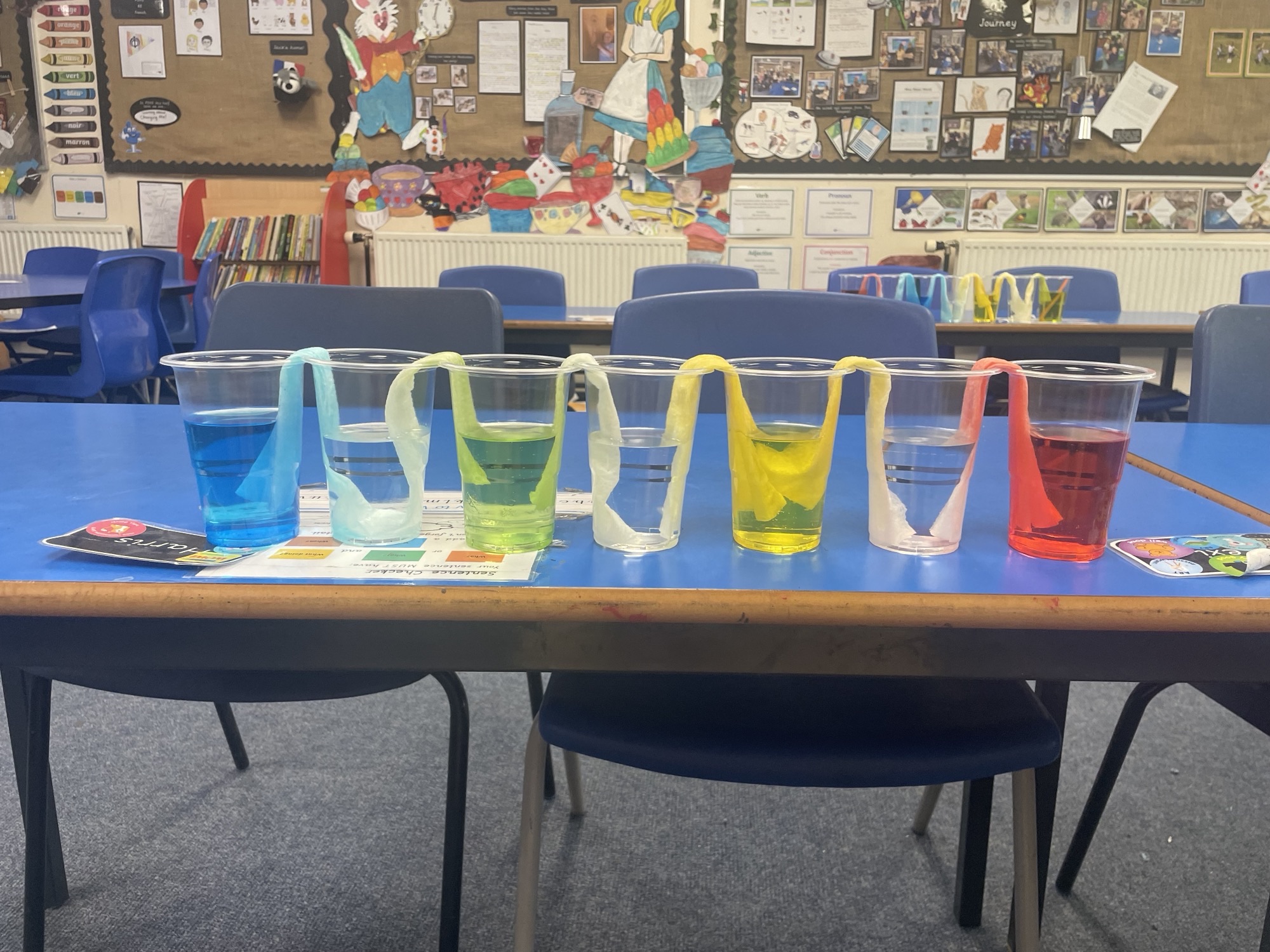
“It was really cool when the paper towels changed colour, I was right when I said that the one between the yellow and blue would turn green” “I can’t believe my egg didn’t smash, I thought it was going to once Miss Morrison stood on the chair to drop it!” “The best lesson was when we created a way to stop our egg from cracking because we got to use lots of different materials”
It’s hard to believe that this has been our last term as a year 4 class, and what a term it has been! The children have shined. We have thoroughly enjoyed seeing their discussions and ideas and are so proud of how well all of the pupils have worked together. We’ve had so much fun in science this year and this unit of work has been the cherry on top! We can’t wait to see what they all get up to next year.
Miss Morrison and Miss Friend
Science - Materials
In science this half term, we have been learning all about everyday materials and their properties. We began the topic by collecting a range of materials, and discussed as a class, what they looked like, felt like, and some of their properties. We then developed our scientific knowledge further by discussing the difference between an object and a material. We went on a hunt around the school to find different objects, and talked about which was the most common material. Our findings showed that lots of the objects throughout school are made out of plastic and metal! We think that this is because they are strong, so they won't break easily, and they'll last a long time.
We have conducted a number of teacher and child led experiments throughout the half term, including a test to see which material would be the best for an umbrella and which material is the most flexible. Our favourite experiment, though, was an observation over time. We buried different materials deep in our allotments, and made a prediction as to what we thought was going to happen to the materials after being left in the soil for a week. Some of our predictions really impressed Miss Naughton, and some of them were even correct!
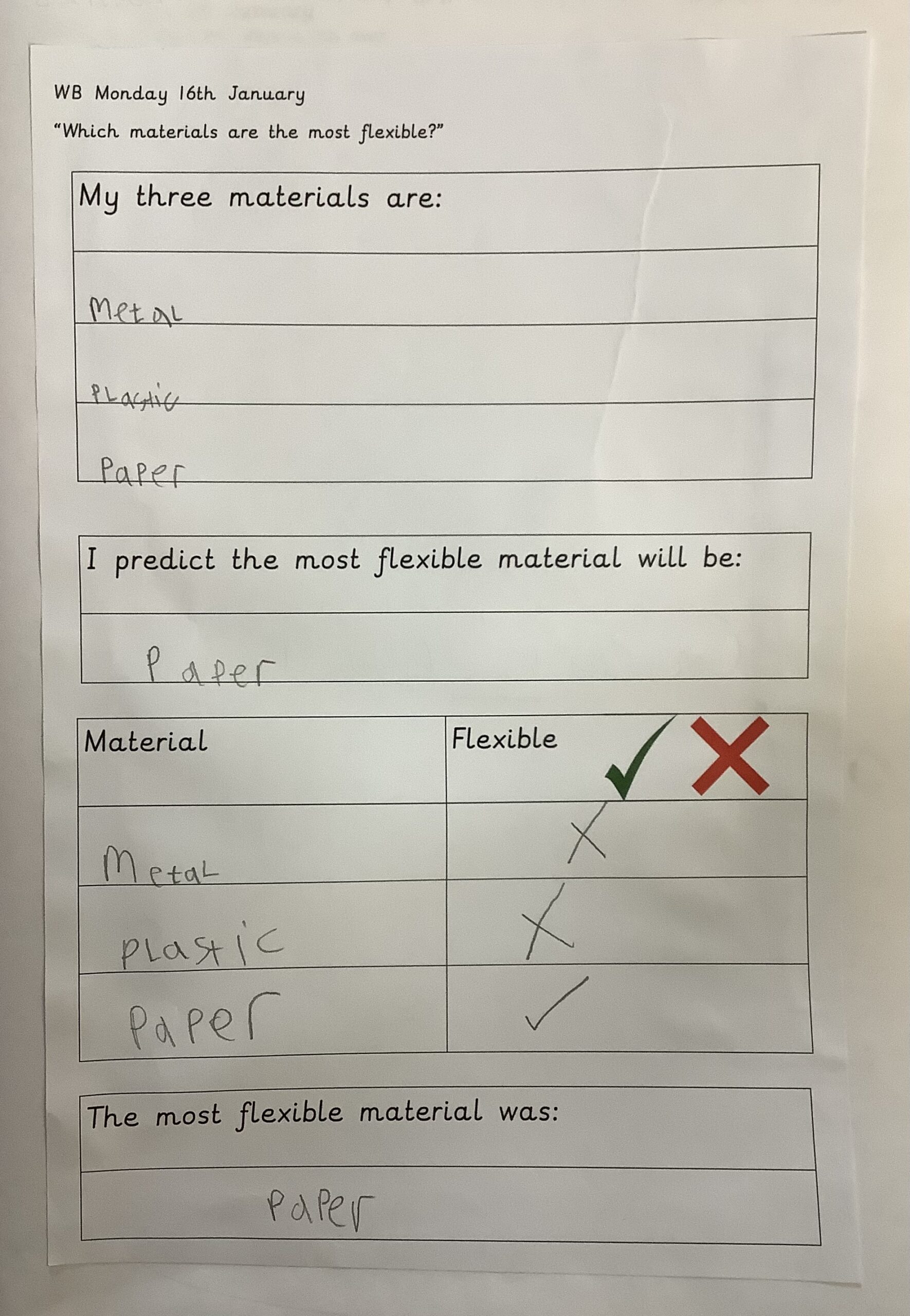
"Some materials are really hard and some are soft and squishy. Metal is hard." "I liked when we dug up our materials. The paper had changed colour and it started to break apart. It was all wet from being in the mud." "I think the best material for an umbrella us plastic. It is strong and waterproof." "I thought the plastic was going to explode in the mud but it just got all wet. There was lots of mud inside it." "Sometimes plastic is hard and sometimes it can be soft. Some toys are made out of plastic. Lots of things in school are made out of plastic and metal, and sometimes wood." - Year 1 children
The children's scientific knowledge and engagement throughout this topic has really impressed me this half term. They have begun to make sensible and realistic predictions, and have been able to explain their thinking behind making such predictions. The way the children have got stuck in with experiments and investigations, and come up with their own scientific ideas has been great to see. It has also been lovely to witness children using their science knowledge outside of lessons and during provision time, by making shelters for animals and discussing which material would be the best the and why. Well done year 1! - Miss Naughton, Class Teacher
Year 5 science
The children have been busy this half term learning about the properties of materials in science. We have discovered what a property and a material is and have been investigating how different materials change. The children have identified the difference between a mixture and a solution had a go at separating solutions and mixtures using sieves, filters and by boiling hot water. We have also been experimenting with reversible and irreversible changes. We have discovered that materials can change and then be changed back, such as ice melting back to water. During this investigation we made lava lamps using oil, water and alka seltzers, which demonstrated how other changes are irreversible, meaning the materials cannot be easily changed back.
Through discussion and investigations that the children have carried out themselves, they have developed their scientific vocabulary and their skills and impressed us with their ideas and explanations.
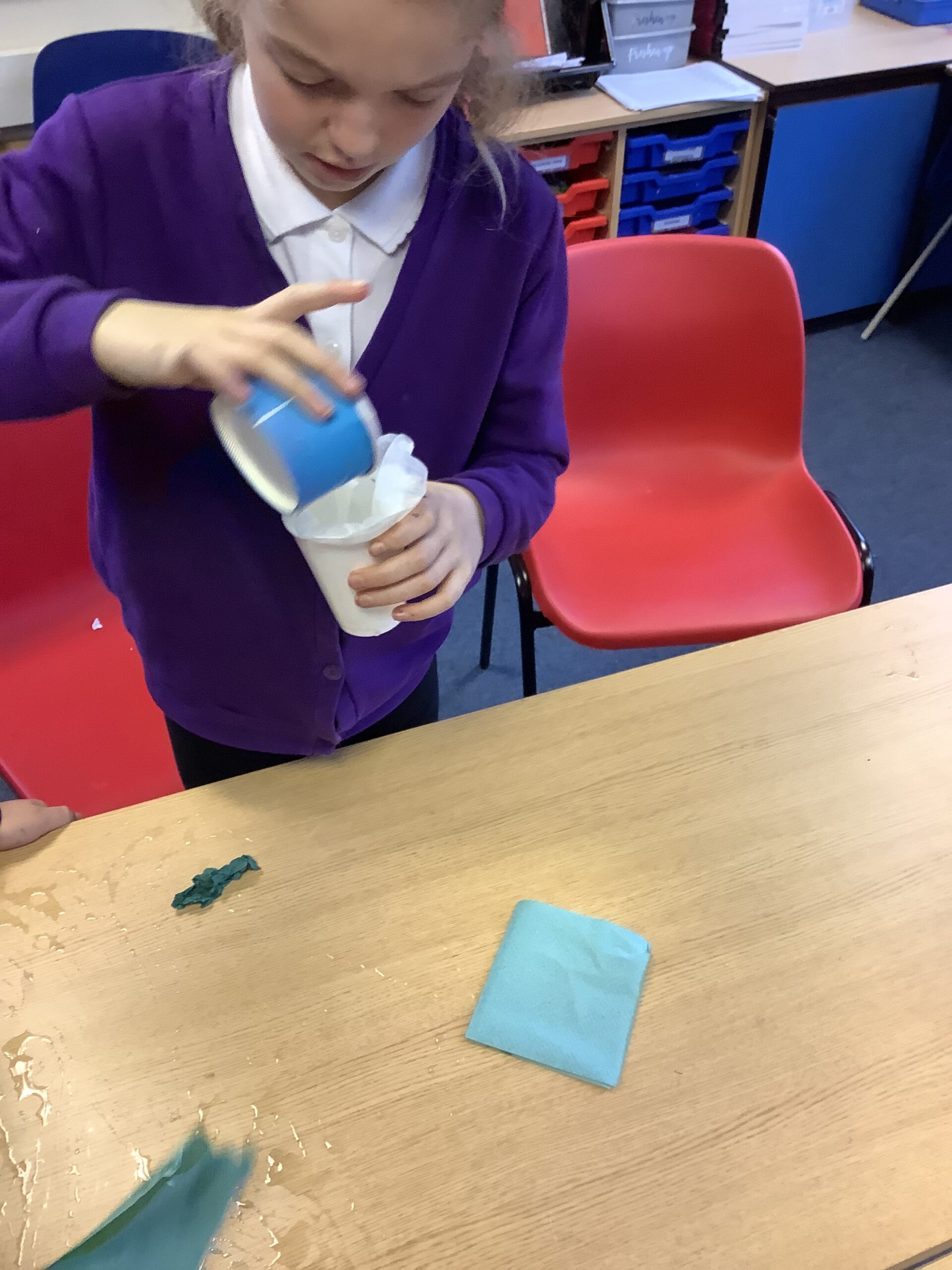
"I enjoy science because we do lots of experiments which help us learn more" "The best experiment was making the lava lamp using oil, water, food colouring and alka seltzers"
We have been very pleased with the children's enthusiasm for learning this half term. It has been lovely to see them excited about science and we have been impressed with their investigation and team work skills . - Miss James and Miss Buxton, Class Teachers.
This half term in science we have been learning about keeping our bodies healthy. The children have explored the importance of exercise, eating the right foods and being hygienic.
To begin our topic, the children carried out an investigation into the effect of exercise on our bodies. The children did different exercises and were asked to think about what was happening to their bodies. They had to think about how different exercises made their bodies feel. After a lot of running and ball skills, it was fair to say that a lot of the children felt exhausted!
During this topic, we have also had the opportunity to think about what we eat and how we can eat the right things. While learning about the different food groups, the children designed their own lunch boxes and made sure they filled them with lots of healthy snacks. We even tasted foods from the different food groups such as apples, bread, sausages and cheese. The children were fantastic at recognising which foods belonged to each food group and deciding which foods we should put in our lunch boxes.
The children also enjoyed doing an experiment to find out more about our hygiene. We learnt about how important it is to wash our hands properly and what might happen if we don't. As part of the experiment, the children put three slices of bread in bags with gloves, clean hands and dirty hands. Over the next few weeks, we will be observing what happens to the different slices of breads
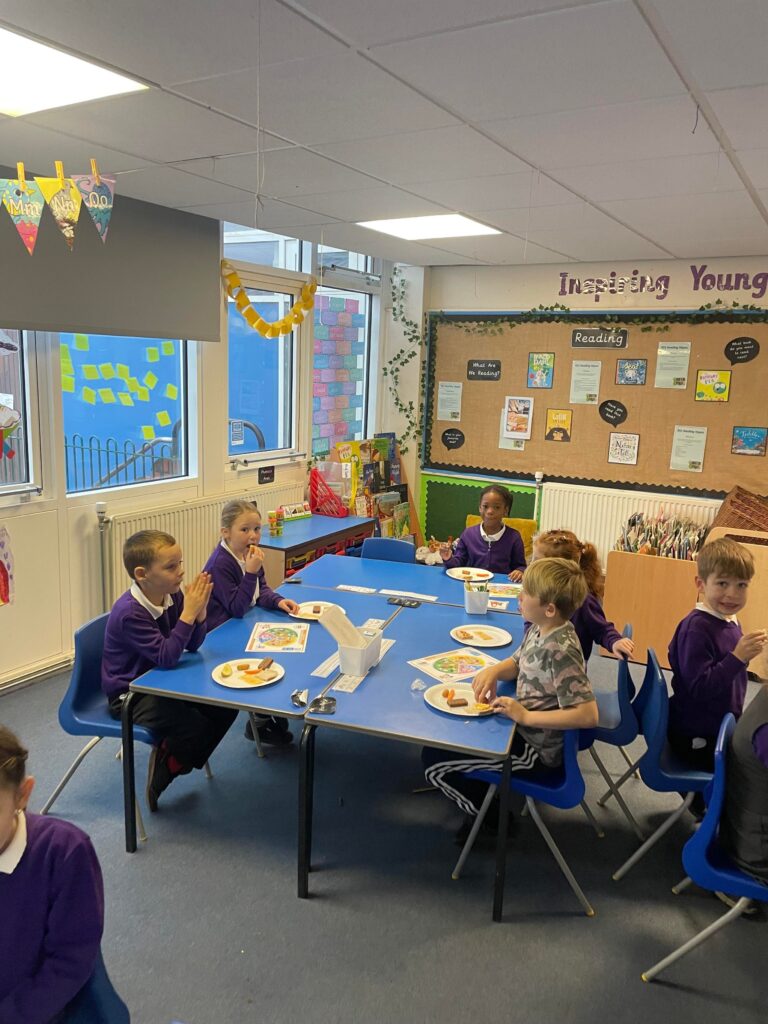
"Running is hard, my legs feel like jelly"- Year 2 pupil "My heart beats fast when I run"- Year 2 pupil "Apples are healthy. They are in the fruit and vegetables group"- Year 2 pupil "The slice of bread where we used our clean hands will still grow mould because washing our hands doesn't get rid of all the germs"- Year 2 pupil "The cheese tastes funny"- Year 2 pupil "I feel calmer when I am walking rather than running"- Year 2 pupil "The bread will be green and mouldy when we look at it next week"- Year 2 pupil
It has been amazing to see the children so excited for their science lessons. They have really developed their scientific skills and it is great to see them using these in their science lessons. - Miss Cannon, Year 2 Class Teacher
Earth and Space
Space: the final frontier!
Year 5 have been enthusiastically learning about space and earth this half-term. The children have learning plenty of new vocabulary and understood how Earth orbits the Sun and how our moon orbits Earth. They have become experts at knowing the planets’ names by remembering their own mnemonic! During the lesson, we took our learning outside and thought carefully about the sizes of each planet and related them to a piece of fruit and then put our fruit planets in correct order using their mnemonic. We also places the planets in a (very) scaled down version distances away from the Sun to get some perspective of the size of our solar system.
After learning the waxing and waning moon phases, the children produced a great poster for our science display made from Oreo cookies – carefully carving the cream away to consolidate their learning of the different appearances of the moon. They particularly enjoyed eating the leftovers once the lesson had finished!
Finally, we investigated how night and day occurs on Earth. Children had to prove/disprove if the Sun moves around the Earth to get night and day. To do this, they worked in groups with a torch and globe and had some great conversations and thoughts about how night and day happens and discovered how and why the Sun rises in the east and sets in the west. We now know that the Earth rotates on an invisible axis (anti-clockwise), whilst revolving (orbitting) around the Sun (which stays in the same place!).
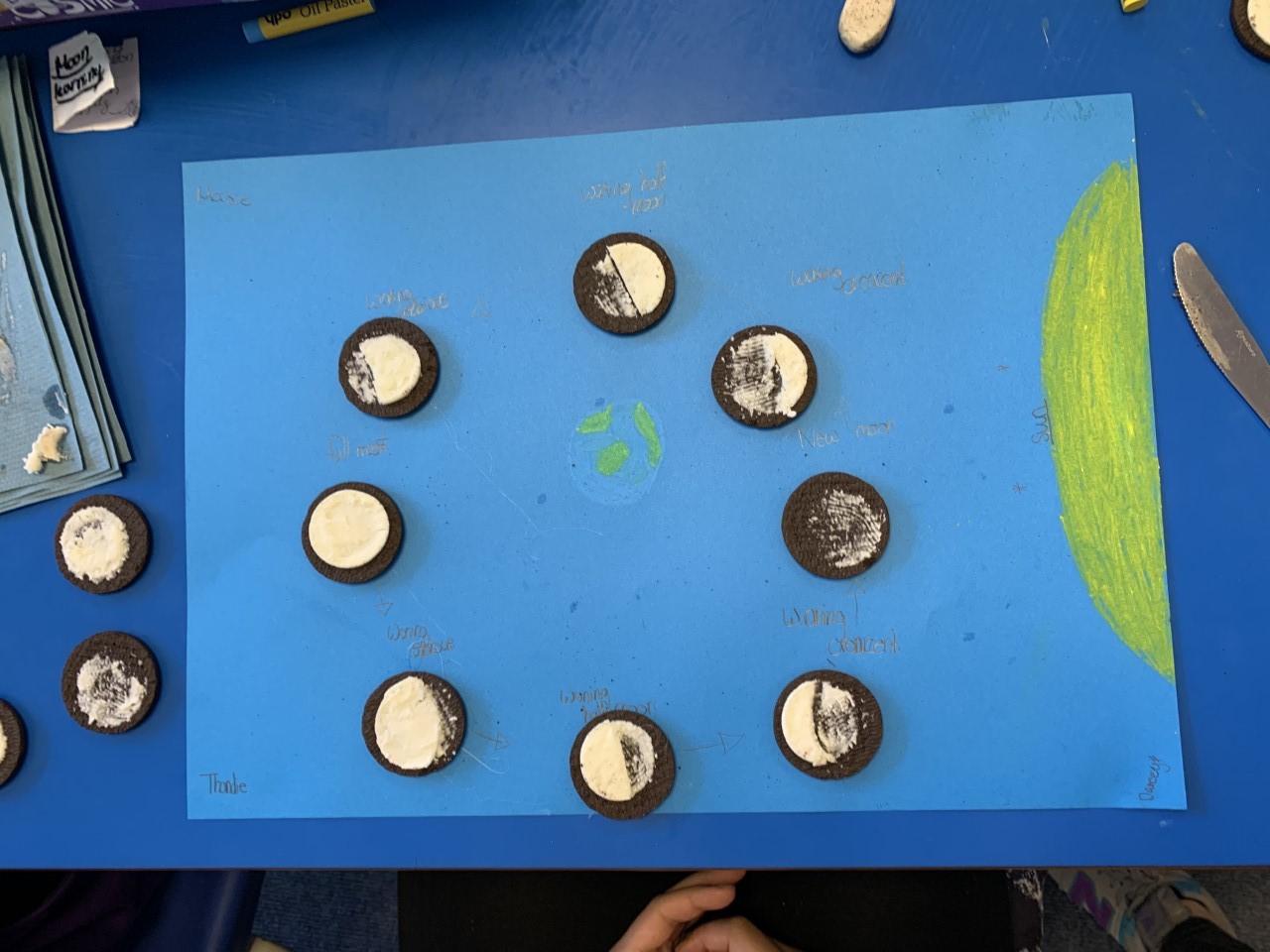
"'M VEM J SUN' I'll never forget the order of the planets now!" "I love science - it is so interesting. I love how we find things out when we do experiments" "I have done some extra homework - can I read the facts I found out to the class?" "I want to go into space when I am older."
We have really seen the children engaged with their learning during the Earth and Space unit. They have thoroughly enjoyed the practical aspects to consolidate their learning and this has really helped the information to be remembered. We loved hearing the enthusiasm of the class when they were asking questions in the lessons - showing great scientific enquiry - some of which they answered themselves by researching in their own time! - Miss Holmes and Miss O'Connell, Class Teachers.
Year 2 - Living Things and Their Habitats
This half term, the children have been introduced to the idea that all living things have certain characteristics that are essential for keeping them alive and healthy. They started by identifying what a living thing is. Once they knew this, the children learned about habitats and microhabitats and discussed where living things can be found in the local area as well as further afield. They thought about how animals have adapted to their environment and how food chains dictate where their habitats are. In a workshop, as part of science week, they sorted animals based on whether they have a back bone as well as the structure and position of their skeletons.
The children worked scientifically by sorting and classifying things according to whether they are living, dead or were never alive, questioning their own and others ideas and they also recording their findings using tally charts.
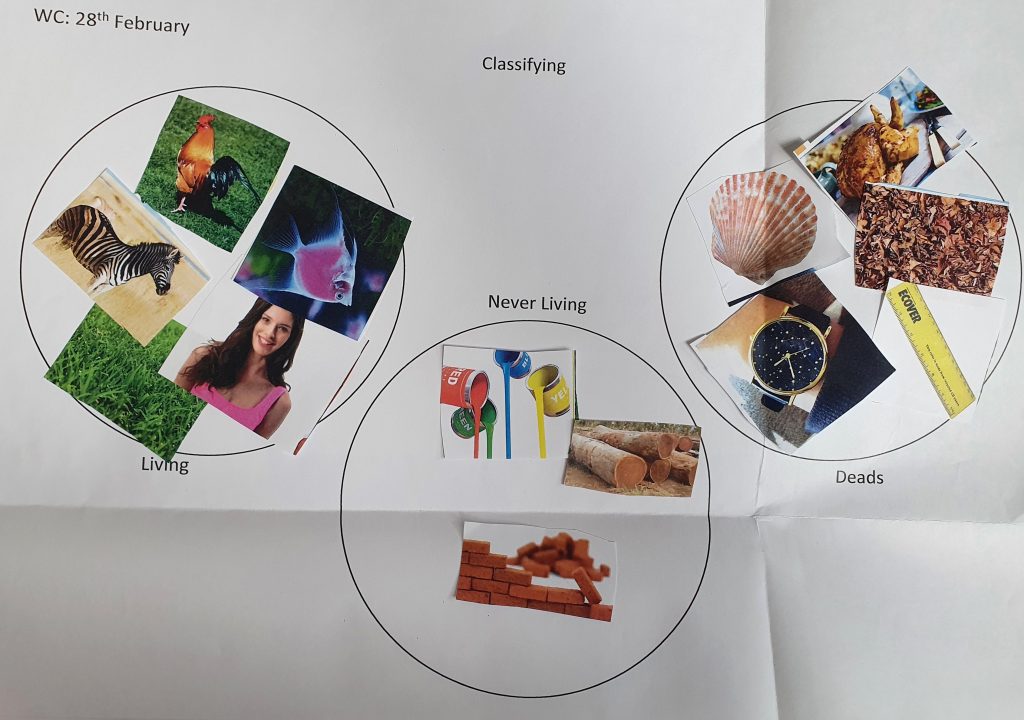
"I liked learning this topic because I now know where lots of animals live. Like the rainforest and the desert" "I liked learning about the habitats because jaguars sneak up on zebras and eat them!" "It was fun because we learned about new animals all together and if they were carnivores, herbivores or both." "I know lots about animals. Blubber can keep seals and elephant seals warm inside. Also jaguar and leopards backbones move so that they can turn if they smell their prey."
"This has been one of my favourite science topics to teach as it is a wonderful opportunity for me to learn about different living things too. The children shared lots of knowledge about different animals and plants they learned about in year 1 and from books. They have enjoyed building on this knowledge by learning about how living things adapt to their environment and what they need to survive. I particularly enjoyed seeing the children create plasticine animals to put into their habitat. The conversations between the children about which animals they needed to make was wonderful. It was also lovely to see the children exploring our outdoor area to find microhabitats and the living things which exist there." - Mrs Jones, Class Teachers.
Animals including Humans
This term in Year 3, we are going to be identifying that animals, including humans, need the right types and amount of nutrition, and that they cannot make their own food; they get nutrition from what they eat. We are also going to be identifying that humans and some other animals have skeletons and muscles for support, protection and movement.
This week in science we have been learning about animal classifications- Omnivores, Carnivores and Herbivores. We used a Venn diagram to classify different animals, after discussing what food they eat.
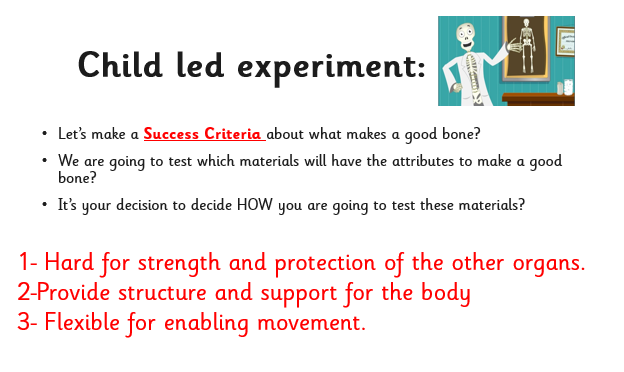
'' I love Science. I loved making bones out of clay and testing which materials made the best bones.'' '' Science is cool. You do fun experiments.''
* The children had an opportunity to identifty that animals, including humans, need the right types of nutrition by examining food groups and nutrient groups. They learnt the difference between food groups and their nutritional value. *They were taught appropriate scientific language and terms to communicate ideas and explain the behaviour of living things. *They learnt key facts about skeletons inside human and different animals. They learnt to Identify that humans and some other animals have skeletons by investigating skeleton types and learnt to sort animals based on their skeletons.
''I have really enjoyed teaching this topic and helping the children learn more about the human body. I am really impressed with how well they have understood key concepts and proud of how much they want to learn new things in science.''
This website uses cookies, or tiny pieces of information stored on your computer, to verify who you are when you are logged in to the administration area.
We use the following types of cookies:
| Provider | Cookie name | Purpose | Further information |
|---|---|---|---|
| Website | ir_test | This tests whether the device is suppressing cookies | |
| Website | cke | This cookie is used to remember whether you wish to view the cookie notice or not. | |
| Google Analytics | _ga _gat_gat_oxRollUpTracker_gat_UA-***** | These cookies are used to collect information about how visitors use our site. We use the information to compile reports and to help us improve the website. The cookies collect information in an anonymous form, including the number of visitors to the website, where visitors have come to the site from and the pages they visited. | Overview of Google Analytics privacy |
Cookies are used by WooCommerce in a variety of ways.
Cookies depend on specific features that are enabled on a store. The cookies are active when a user interacts with one of these features or to allow admin functions to be performed from within the store’s dashboard (/wp-admin).
Details are provided in tables below, listing various cookies that are set for users of stores with the WooCommerce plugin installed.
| COOKIE NAME | DURATION | PURPOSE |
|---|---|---|
woocommerce_cart_hash | session | Helps WooCommerce determine when cart contents/data changes. |
woocommerce_items_in_cart | session | Helps WooCommerce determine when cart contents/data changes. |
wp_woocommerce_session_ | 2 days | Contains a unique code for each customer so that it knows where to find the cart data in the database for each customer. |
woocommerce_recently_viewed | session | Powers the Recent Viewed Products widget. |
store_notice[notice id] | session | Allows customers to dismiss the Store Notice. |
No personal information is stored within these cookies.
/wp-admin):| COOKIE NAME | DURATION | PURPOSE |
|---|---|---|
woocommerce_snooze_suggestions__[suggestion] | 2 days | Allows dashboard users to dismiss Marketplace suggestions, if enabled. |
woocommerce_dismissed_suggestions__[context] | 1 month | Count of suggestion dismissals, if enabled. |
tk_ai | session | Stores a randomly-generated anonymous ID. This is only used within the dashboard (/wp-admin) area and is used for usage tracking, if enabled. |
What it does: This cookie is used by the Wordfence firewall to perform a capability check of the current user before WordPress has been loaded.
Who gets this cookie: This is only set for users that are able to log into WordPress.
How this cookie helps: This cookie allows the Wordfence firewall to detect logged in users and allow them increased access. It also allows Wordfence to detect non-logged in users and restrict their access to secure areas. The cookie also lets the firewall know what level of access a visitor has to help the firewall make smart decisions about who to allow and who to block.
What it does: This cookie is used to notify the Wordfence admin when an administrator logs in from a new device or location.
Who gets this cookie: This is only set for administrators.
How this cookie helps: This cookie helps site owners know whether there has been an admin login from a new device or location.
What it does: Wordfence offers a feature for a site visitor to bypass country blocking by accessing a hidden URL. This cookie helps track who should be allowed to bypass country blocking.
Who gets this cookie: When a hidden URL defined by the site admin is visited, this cookie is set to verify the user can access the site from a country restricted through country blocking. This will be set for anyone who knows the URL that allows bypass of standard country blocking. This cookie is not set for anyone who does not know the hidden URL to bypass country blocking.
How this cookie helps: This cookie gives site owners a way to allow certain users from blocked countries, even though their country has been blocked.
To enrich our website content, sometimes we may embed video content from other social media websites such as YouTube or Facebook. As a result, when you visit a page with content embedded, you may be presented with cookies from these websites. This website has no control or liability over these cookies set, so you should check the relevant third party’s cookie policy for more information.
We also offer a ‘share page’ widget on some of our web pages, where content can be shared easily on the following sites – Facebook, Twitter, MySpace, Delicious and Digg. These sites may set a cookie when you are logged into their service. This website has no control or liability over these cookies set, so you should check the relevant third party’s cookie policy for more information.
Some links and resources are provided below to assist your understanding of the types of cookies you may encounter.
| Provider | Cookie name | Purpose | Further information |
|---|---|---|---|
| Google maps | NID PREF khcookie | These cookies are used by Google to track how many people are using their maps | Overview of Google privacy |
| YouTube | use_hitbox VISITOR_INFO1_LIVE | YouTube may still set cookies on the user’s computer once the visitor clicks on the YouTube video player, but YouTube will not store personally-identifiable cookie information for playbacks of embedded videos using the privacy-enhanced mode. | Google Technology |
| lang pidmetrics_token | We have the Twitter Share widget in place on the site which makes use of cookies. May include targeted advertising cookies. | Twitter Privacy Policy Twitter Articles | |
| PREF NID | Cookies related to Google. May include targeted advertising cookies used on our social media hub. | Google Cookies Google Types | |
| _bizo_bzid _bizo_cksm _bizo_np_stats | Targeted advertising cookies from LinkedIn. | LinkedIn Cookie Policies | |
| CloudFlare | _cfduid | Identifies a single machine as safe to connect behind a shared IP so challenges do not have to be reissued. | Cloudflare Cookie Policy |
This website will not use cookies to collect personally identifiable information about you. However, should you choose to disable, reject or block our cookies, some parts of our website will not function fully, or in some cases, our website will not be accessible at all.
Most web browsers allow some control of most cookies through the browser settings. To find out more about cookies, including how to see what cookies have been set and how to manage and delete them please visit http://www.allaboutcookies.org/.
For detailed information on the use of cookies within the WordPress ecosystem please visit https://codex.wordpress.org/WordPress_Cookies
Any changes we may make to our Cookie Statement in the future will be posted on this page.
Last Updated: 12/02/21
We regard your privacy as important and any personal information you give to us will be used in accordance with the Data Protection Act and the General Data Protection Regulations.
We do not store personal information about individuals who visit this site except where they provide contact information via our contact us page and contact forms available on various pages throughout the website.
Any information you provide will only be used for the reasons specified and it will not be shared with any third party without your consent, unless required by law.
Your contact details are kept securely and are only accessed by authorised members of staff as part of the provision of school services. If you do not wish us to keep this contact information please tell us.
This website uses Google Analytics which provides statistical data about the usage of the site. This information is not used to identify individuals, but is collected to provide us with an understanding of the areas of interest on our site and how our site is being used.
If you are connected to the internet you will have an IP Address. This may take the form of a figure, such as 333.333.22.1. The address will be automatically collected and logged as part of the connection of your computer to our web server and may be used to determine the total number of visits to each part of the site. This data is not collected and used for other purposes.
This website contains links to other websites. The School is not responsible for the privacy practices of other sites or organisations and recommends you consult the privacy information on those sites.
This policy will be reviewed and updated versions will be posted on the website.
If you have any questions about the use of your personal information, the Information Commissioner is the independent regulator for both Data Protection and Freedom of Information.